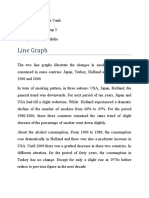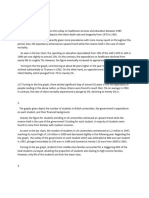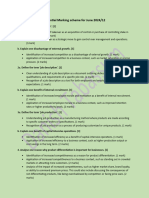Percentage of Tourists To England Who Visited Brighton Attractions
Percentage of Tourists To England Who Visited Brighton Attractions
Uploaded by
Pẹtt OsameoCopyright:
Available Formats
Percentage of Tourists To England Who Visited Brighton Attractions
Percentage of Tourists To England Who Visited Brighton Attractions
Uploaded by
Pẹtt OsameoOriginal Title
Copyright
Available Formats
Share this document
Did you find this document useful?
Is this content inappropriate?
Copyright:
Available Formats
Percentage of Tourists To England Who Visited Brighton Attractions
Percentage of Tourists To England Who Visited Brighton Attractions
Uploaded by
Pẹtt OsameoCopyright:
Available Formats
Percentage of tourists to England who visited Brighton
attractions
The given line graph demonstrates the proportion of visitors to
England who travelled to four different attractions in Brighton over
the course of 30 years starting from 1980.
Overall, it is clear that the proportion of visitors traveling to the
Pavilion and the Pier increased over the period, while the percentage
of travelers to other attractions fell. The most popular Brighton
destination in 1980 for visitors to England was the Festival, Pavilion
was the most popular attraction out of the others though.
In 1980, Pavilion fascinated more than 20% of tourists, more than
double the records of Pier. During the 1980s and 1995s there was a
sharp increase in travelers to the Pavilion from over 20% to almost
50% before the percentage gradually went down to 30% in 15 years
later. While travellers to the Pier also fluctuated from 1980 to 2000
then rose significantly from 10% to 22% between 2000 and 2010.
On the other hand, the opposite trend was true for the other places.
In the initial year, Festival illustrated the highest percentage of exactly
30% compared to the others. Nevertheless, it slightly decreased with
minor fluctuations and got around 27% at the end of this period.
Despite a dramatic growth to under 40% in 1985, Art Gallery
declined over the remainder period and became the least attraction in
2010 and got less than 10%.
Oil use of major consumers
The given line graph gives information about the oil consumption
per day of four different regions between 2009 to 2030.
Overall, the USA was by far the biggest consumer of oil from 2009
until present and is predicted to remain the biggest consumer until
2030. From 2015, oil consumption in Western Europe & Japan and
also in the US is predicted to decrease, by contrast to the expected
increase in China and Middle East.
In 2009, oil consumption in the USA was around 10 million barrels
per day to 2015, before beginning to fall. The figures were
considerably lower for Western & Japan at 4 million, and China and
Middle East at 2 billion barrels each. While the consumption went
down in Western Europe & Japan by 2015 and reached a peak in the
US, there was an increase in oil consumption in China and Middle
East.
In contrast, different trends can be seen in the figures of all areas by
2030. The number of barrels of oil consumed daily in the US is
predicted to drop to about 4 billion. Meanwhile, the oil consumption
is expected to decrease to 2 billion barrels in Western Europe &
Japan. However , in the Middle East, a rise in the amount of oil
consumed is anticipated to reach a peak of 3 million barrels in 2030.
This is slightly lower than the estimated data in China, at about under
4 million barrels per day.
You might also like
- DR Tim Williams: I Wouldn't Start From Here - Towards The Transport Revolution Sydney NeedsDocument95 pagesDR Tim Williams: I Wouldn't Start From Here - Towards The Transport Revolution Sydney NeedsNo WestCONnex PublicTransportNo ratings yet
- Supply Chain Management: Strategy, Planning, and Operation: Seventh EditionDocument55 pagesSupply Chain Management: Strategy, Planning, and Operation: Seventh Editionsidhartha mohapatraNo ratings yet
- TASK 1 Writing IeltsDocument17 pagesTASK 1 Writing IeltsIntan Hajar FauzaninNo ratings yet
- IELTS Writing Vol 2Document13 pagesIELTS Writing Vol 2Linh Anh NguyenNo ratings yet
- Lê Minh Khuê - Line Graph With FutureDocument1 pageLê Minh Khuê - Line Graph With Futureleminhkhue1970No ratings yet
- Writing Task 1 Samples 7.0Document53 pagesWriting Task 1 Samples 7.0Phan Đình TrungNo ratings yet
- SampleDocument32 pagesSampleBùi Thị Hoài ThươngNo ratings yet
- Line GraphDocument84 pagesLine GraphJm NiroulaNo ratings yet
- The Line Graph Below Shows The Percentage of Tourists To England Who VisitedDocument2 pagesThe Line Graph Below Shows The Percentage of Tourists To England Who VisitedHải ThếNo ratings yet
- Band 9 Essay Bank: Academic Task 1-Sample 1Document12 pagesBand 9 Essay Bank: Academic Task 1-Sample 1parinaaz kaurNo ratings yet
- Writing 1 - Line Graph - Sample 1Document1 pageWriting 1 - Line Graph - Sample 1Trần NhânNo ratings yet
- Writing Task 1Document131 pagesWriting Task 1Anh Minh Thân ĐứcNo ratings yet
- Ielts Writing Task 1Document2 pagesIelts Writing Task 1তানভীর ইবনে গিয়াসNo ratings yet
- (Writing Task 1) Useful LanguageDocument17 pages(Writing Task 1) Useful LanguageThuNo ratings yet
- Task 1 ExamplesDocument4 pagesTask 1 ExamplesKhanh LinhNo ratings yet
- 中级班写作课笔记+作业7 19Document10 pages中级班写作课笔记+作业7 1920080508zyrNo ratings yet
- Task 1 (Line Graph) - Tourists To England Who Visited Four Different Attractions in Brighton.Document1 pageTask 1 (Line Graph) - Tourists To England Who Visited Four Different Attractions in Brighton.Diệuu LinhNo ratings yet
- Simon's Sample EssaysDocument57 pagesSimon's Sample EssaysNguyễn Ngọc HươngNo ratings yet
- Graphs Writing Task 1Document27 pagesGraphs Writing Task 1Shefali ChauhanNo ratings yet
- Line GraphDocument13 pagesLine GraphMikelAgberoNo ratings yet
- INTENSIVE WRITING IELTS TASK 1 - Luu Anh DucDocument8 pagesINTENSIVE WRITING IELTS TASK 1 - Luu Anh DucTô Anh ĐứcNo ratings yet
- Slide 10 - Writing Task 1 - Dynamic Chart - Future TaskDocument13 pagesSlide 10 - Writing Task 1 - Dynamic Chart - Future TaskPhương Ngọc PeenNo ratings yet
- W 2Document3 pagesW 2nhongquan2201No ratings yet
- Miêu tả biểu đồ: Line chart, bar chart, pie chartDocument18 pagesMiêu tả biểu đồ: Line chart, bar chart, pie chartエンイNo ratings yet
- WritingDocument12 pagesWritingekatgorevaNo ratings yet
- Changes by SimonDocument12 pagesChanges by SimonThư NguyễnNo ratings yet
- Changes by SimonDocument12 pagesChanges by SimonThư NguyễnNo ratings yet
- De Writing Task 1Document19 pagesDe Writing Task 1api-27550358100% (1)
- Writing Task 1 - Simon - RemovedDocument25 pagesWriting Task 1 - Simon - Removedngthuthao210104No ratings yet
- The Chart Below Shows The Average Time Commuters Spent Travelling To Work Each Day in Four Australian Cities Between 2002 and 2010Document17 pagesThe Chart Below Shows The Average Time Commuters Spent Travelling To Work Each Day in Four Australian Cities Between 2002 and 2010Thuy Hien DangNo ratings yet
- biểu đồDocument5 pagesbiểu đồtragiang1302No ratings yet
- Writing-1 (209 Words) : VisitingDocument11 pagesWriting-1 (209 Words) : VisitingAnkur TripathiNo ratings yet
- Avoid repetitionDocument4 pagesAvoid repetitionHường ĐoànNo ratings yet
- Simon's Task 1 SamplesDocument77 pagesSimon's Task 1 SamplesBáchHợp100% (1)
- Writing PortfolioDocument3 pagesWriting PortfolioCảnh DươngNo ratings yet
- Writing Task 1 Sample ReportsDocument76 pagesWriting Task 1 Sample ReportsHoàng Ngọc TânNo ratings yet
- Oil Consumption - Bao UyenDocument1 pageOil Consumption - Bao UyenBảo UyênNo ratings yet
- Task 1 - Line Graphs - by OlimjonDocument38 pagesTask 1 - Line Graphs - by OlimjonwyikrzNo ratings yet
- The Chart Graph Shows The Percentage of Tourists To Scotland Who Visited Four Different Types of Attractions From 1980 To 2010Document2 pagesThe Chart Graph Shows The Percentage of Tourists To Scotland Who Visited Four Different Types of Attractions From 1980 To 2010Phuong NguyenNo ratings yet
- DOL Sample Task 1Document58 pagesDOL Sample Task 1Kim Châu ĐàmNo ratings yet
- Task 1 - Simon (Tham khảo) -đã chuyển đổiDocument80 pagesTask 1 - Simon (Tham khảo) -đã chuyển đổiminhthuphamdiep0711No ratings yet
- AE IELTS Line GraphDocument2 pagesAE IELTS Line GraphZhoha NurakhanNo ratings yet
- Writing Task 1Document21 pagesWriting Task 1Radwan AhmedNo ratings yet
- Ielts Writing Task 1 SimonDocument27 pagesIelts Writing Task 1 SimonQuỳnh Trâm TrầnNo ratings yet
- Practice Task 1Document7 pagesPractice Task 1Hương ĐặngNo ratings yet
- The Line Graph Below Shows The Percentage of Tourists To England Who Visited Four Different Attractions in BrightonDocument1 pageThe Line Graph Below Shows The Percentage of Tourists To England Who Visited Four Different Attractions in BrightonLe Hoang LinhNo ratings yet
- Renewable Energy 5Document4 pagesRenewable Energy 5quyetle692002No ratings yet
- Screenshot 2021-03-12 at 9.16.14 PMDocument57 pagesScreenshot 2021-03-12 at 9.16.14 PMQuỳnh Anh TrươngNo ratings yet
- Academic Writing IeltsDocument12 pagesAcademic Writing IeltsMikelAgberoNo ratings yet
- No ChangeDocument11 pagesNo Changethycam105805No ratings yet
- Lê Nguyễn Bảo Hùng - combination graphDocument2 pagesLê Nguyễn Bảo Hùng - combination graphnamedmemory0No ratings yet
- ? Line GraphDocument10 pages? Line Graphuyenpu10112006No ratings yet
- Graph Sample For Ielts To ReadDocument11 pagesGraph Sample For Ielts To ReadgoyeniranNo ratings yet
- Sample Line GraphsDocument4 pagesSample Line GraphsEma StephensNo ratings yet
- Writing Task 1Document41 pagesWriting Task 1Ariful Islam Arif100% (1)
- 30 Sample Essays Band 9 IELTS of SimonDocument29 pages30 Sample Essays Band 9 IELTS of SimonKhang TranNo ratings yet
- All Band 9 Answers by Pauline CullenDocument28 pagesAll Band 9 Answers by Pauline Cullenziyovuddinovmuhammadali16No ratings yet
- Dokumen - Tips - Writing Task 1 Tips and Samples Google DocspdfDocument27 pagesDokumen - Tips - Writing Task 1 Tips and Samples Google DocspdfNHI HUỲNH XUÂNNo ratings yet
- Cost Sheet: Particulars Job 101 Job 102Document12 pagesCost Sheet: Particulars Job 101 Job 102vishal soniNo ratings yet
- Road Infrastructure Financing Models (PPP) (BOT, BOOT, LOT, DBFO, Concession)Document29 pagesRoad Infrastructure Financing Models (PPP) (BOT, BOOT, LOT, DBFO, Concession)Devanjan ChakravartyNo ratings yet
- Corporate Governance and Role of Board of DirectorsDocument13 pagesCorporate Governance and Role of Board of DirectorsSanjayNo ratings yet
- Banana Pack HouseDocument5 pagesBanana Pack Housevskaarthi100% (2)
- Corporate Accounting PDFDocument193 pagesCorporate Accounting PDFK GanesanNo ratings yet
- Semco Unique Self OrganziationDocument12 pagesSemco Unique Self OrganziationAaron Ross100% (6)
- 2008 VolkovDocument26 pages2008 VolkovСофья ВахрушеваNo ratings yet
- Potential Marking Scheme For June 2024 - Paper 1Document5 pagesPotential Marking Scheme For June 2024 - Paper 1nikhildharanNo ratings yet
- ISO-Lecture 01 - Organisations and Information SystemsDocument4 pagesISO-Lecture 01 - Organisations and Information SystemsFadika Malick Christ ElyséeNo ratings yet
- IFoA CT1 201704 ExaminersReportDocument14 pagesIFoA CT1 201704 ExaminersReportdr_rajatjainNo ratings yet
- Global Business Today 10e Global Business Today 10e: Learning Objectives Opening Case: Uber: Going Global From Day OneDocument9 pagesGlobal Business Today 10e Global Business Today 10e: Learning Objectives Opening Case: Uber: Going Global From Day OnePhan Bich HopNo ratings yet
- Bond Issue Donald Lennon Is The President FounderDocument1 pageBond Issue Donald Lennon Is The President FounderDoreenNo ratings yet
- Kids Count 2012 Data Book Full ReportDocument60 pagesKids Count 2012 Data Book Full ReportJamie SandersonNo ratings yet
- RMC No. 5-2024Document7 pagesRMC No. 5-2024Anostasia NemusNo ratings yet
- Colin CO 1Document10 pagesColin CO 1Shrey RanaNo ratings yet
- Class X EconomicsDocument3 pagesClass X EconomicsBhavesh Desai0% (1)
- Fire Protection Systems Market - Innovations & Competitive Analysis - ForecastDocument2 pagesFire Protection Systems Market - Innovations & Competitive Analysis - Forecastsurendra choudharyNo ratings yet
- Value Investing ReportDocument4 pagesValue Investing ReportPrincess Joy Andayan BorangNo ratings yet
- CSR For Healthcare and Sanitation FinDocument2 pagesCSR For Healthcare and Sanitation FinAadarsh MahajanNo ratings yet
- Yambot ECommerceLAB4 PDFDocument6 pagesYambot ECommerceLAB4 PDFYan YanNo ratings yet
- Decoding The Takeover CodeDocument7 pagesDecoding The Takeover CodePayel Jain100% (1)
- DellDocument12 pagesDellNishtha GargNo ratings yet
- GST Compliance in Statutory Bank Branch Audit: Ca. Vineet RathiDocument46 pagesGST Compliance in Statutory Bank Branch Audit: Ca. Vineet Rathianon_127497276No ratings yet
- A3 - Handbook of Procedures For Investing in Mexico AnexoDocument43 pagesA3 - Handbook of Procedures For Investing in Mexico AnexoAlbertNo ratings yet
- Chap - 9 Book Keeping XI HALLDocument114 pagesChap - 9 Book Keeping XI HALLKirtee TiwariNo ratings yet
- Creating Sustainable Value - L. Hart and B. Milstein 2011Document22 pagesCreating Sustainable Value - L. Hart and B. Milstein 2011Tõnis Kurss50% (2)
- Republic of The Philippines AMA Computer College Pasig BranchDocument18 pagesRepublic of The Philippines AMA Computer College Pasig BranchMika GalutNo ratings yet
- Ashok LeylandDocument16 pagesAshok LeylandHarsheshChopraNo ratings yet

























































































